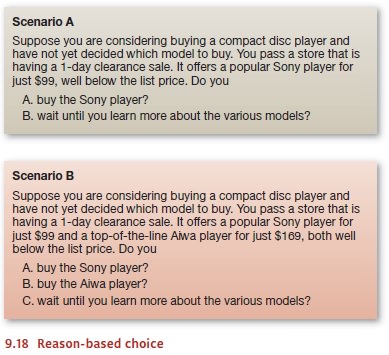Chapter: Psychology: Thinking
Decision Making: Reason-Based Choice
Reason-Based
Choice
How should we think about the
data we’ve reviewed? On the one side, our everyday experience suggests that we
often make good decisions—and so people are generally quite pleased with the
cell-phone model they selected, content with the car they bought, and happy
with the friends they spend time with. At the same time, we’ve considered
several obstacles to high-quality decision making: People can easily be tugged
one way or another by framing; they’re often inaccurate in predicting their own
likes and dislikes; and they seek out lots of choice and flexibility but end
up, as a result, less content with their own selections. How should we
reconcile all of these observations?
The answer may hinge on how we evaluate our decisions. If we’re
generally happy with our choices, this may in many cases reflect our
contentment with how we made thechoice rather
than what option we ended up with. In
fact, people seem to care a lot abouthaving a good decision-making process and
seem in many cases to insist on making a choice only if they can easily and
persuasively justify that choice.
Why should this be? Let’s start
with the fact that, for many of our decisions, our environment offers us a huge
number of options—different things we could eat, dif-ferent activities we could
engage in. If we wanted to find the best possible food, or the best possible
activity, we’d need to sift through all of these options and evaluate the
merits of each one. This would require an enormous amount of time—so we’d spend
too much of our lives making decisions, and we’d have no time left to enjoy the
fruits of those decisions. Perhaps, therefore, we shouldn’t aim our decisions
at the best possible outcome.
Instead, we can abbreviate the decision-making process if we simply aim at an
option that’s good enough for us,
even if it’s not the ideal. Said differently, it would take us too much time to
opti-mize (seeking the optimum
choice); doing so would involve exam-ining too many choices, and we’ve seen the
downside of that. Perhaps, therefore, we’re better advised to satisfice—by seeking a satisfactory
choice, even if it’s not the ideal, and ending our quest for a good option as
soon as we locate that satisfactory choice (Simon, 1983).
But how should we seek outcomes
that are “satisfactory”? One possibility is to make sure our decisions are
always justified by good reasons, so
that we could defend each decision if we ever needed to. A process like this
will often fail to bring us the best possible out-come, but at least it will
lead us to decisions that are reasonable— likely to be adequate to our needs.
To see how this plays out,
consider a study in which half of the participants were asked to consider
Scenario A in Figure 9.18 (after Shafir, Simonson, & Tversky, 1993). In
this scenario, 66% of the participants said they would buy the Sony CD player;
only 34% said

they would instead wait until
they had learned about other models. Other participants, though, were presented
with Scenario B. In this situation, 27% chose the Aiwa, 27% chose the Sony, and
a much larger number—46%—chose to wait until they’d learned about other models.
In some ways, this pattern is
peculiar. The results from Scenario A tell us that the participants perceived
buying the Sony to be a better choice than continuing to shop; this is clear in
the fact that, by a margin of 2 to 1, people choose to buy. But in Scenario B,
participants show the reverse preference—choosing more shopping over buying the
Sony, again by almost 2 to 1. It seems, then, that participants are
flip-flopping; they pre-ferred the Sony to more shopping in one case and
indicated the reverse preference in the other.
This result makes sense, though,
when we consider that people usually seek a jus-tification
for their decisions and make a choice only when they find persuasive
rea-sons. When just the Sony is available, there are good arguments for buying
it. (It’s a popular model, available at a good price for just one day.) But
when both the Sony and the Aiwa are available, it’s harder to find compelling
arguments for buying one rather than the other. Both options are attractive
and, as a result, it’s hard to justify why you would choose one of these models
and reject the alternative. Thus, with no easy justification for a choice,
people end up buying neither. (Also see Redelmeier & Shafir, 1995, for a
parallel result involving medical doctors choosing treatments for their
patients.)
Related Topics